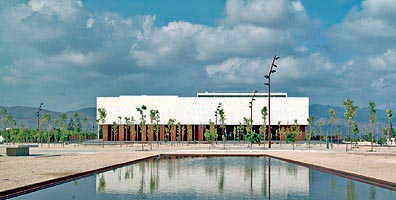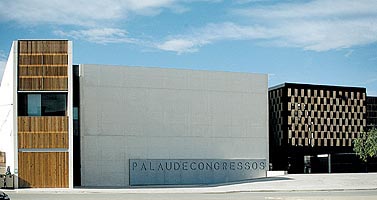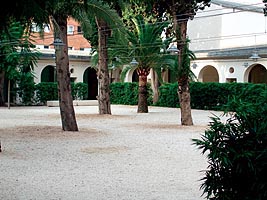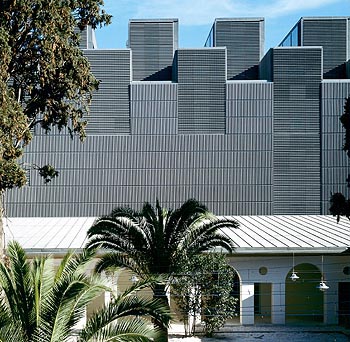

Castelló Cultural
Castelló Cultural

  |
||
|
Castelló Cultural Castelló Cultural
|
 |
|
Premio Especial COACV
2003-2004/2003-2004
COACV Special Prize
|
||
| Cada vez
mas debemos entender la Arquitectura como el resultado final de un
proceso. Un proceso largo, complejo y en muchos tramos del cual el
Arquitecto no posee un control efectivo del mismo. No hay duda de que uno
de estos momentos “fuera de control” es el del encargo. Otro es la
gestión interna de la obra, sobre todo en el caso de los organismos públicos.
Y los dos son momentos necesarios.
Castellón Cultural surge como contrapunto de las grandes inversiones de la Generalitat en Valencia y Alicante. Esta sociedad pública inicia su andadura en Castellón con la sana intención de rellenar el vacío y maltrecho equipamiento territorial en materia de cultura existente en la tercera capital / provincia de nuestra Comunidad. Con grandes dosis de ilusión y un equipo muy profesional a la par que reducido, pone en marcha una serie de acciones donde asume correcta y perfectamente el papel del promotor publico ante la arquitectura, donde el respeto hacia la obra llega a primar sobre otras consideraciones. Si bien hereda de antiguas administraciones dos proyectos y no se resiste a emplear el mecanismo de las adjudicaciones súbitas, pone en marcha dos procesos ejemplares de selección de proyectos. De la mano del Colegio Territorial de Arquitectos de Castellón y asesorados por los mejores profesionales, a través de sendos Concursos de Arquitectura se decide qué profesionales se encargarán de la construcción del Museo de Bellas Artes de Castellón y del Palau de Congresos de Peñíscola. La extrema corrección del proceso de selección se acompañó de un seguimiento en las correspondientes ejecuciones de obra, matizadas y adjetivadas por el diferente talante de los varios gerentes que se han sucedido, con alguna desafortunada actuación. Sin embargo el resultado obtenido, en relación con la cantidad de obra ejecutada, no puede ser mas exitoso. Hasta el punto que ha convertido a Castellón en un imprescindible hito de referencia por cualquier itinerario de arquitectura moderna que se plantee en España. Una simple enumeración abruma: Premio FAD de Arquitectura, el primero que recae en la Comunidad Valenciana para el Museo de Bellas Artes, Un Primer premio de Arquitectura COACV, Dos Premios-Mención del COACV, Un premio ASCER de Arquitectura, un Finalista de la Bienal de Arquitectura, Un finalista de los Premios Mies Van der Rohe ....... avalan suficientemente una trayectoria de tan solo cinco obras construidas. El presente Premio del Colegio de Arquitectos de la Comunidad Valenciana desea reconocer esta labor efectuada y proponer la primera etapa de Castellón Cultural como modelo a seguir por cualquier Administración en la Selección y Gestión de la Obra Publica. Es un premio que se concede también para celebrar el altísimo nivel de calidad de tres de las obras de arquitectura gestionadas y se concede por ultimo para señalar y apuntalar un modelo a seguir. Un modelo válido pero muy, muy fácil de corroer entre la Babel de voces mas o menos autorizadas que pueden elevarse durante todo el tiempo que perdura el proceso de gestación de cualquier arquitectura. Deseo vivamente que así no sea. Jaime Prior
Llombart |
Increasingly, architecture should be understood as the end result of a process. It is a long, complex process and the architect does not have effective control over many of its stages. One of the ‘out of control’ moments is the commissioning stage. Another is the in-house works management, particularly in the case of public bodies. Both are necessary stages. Castellón Cultural was set up as a counterpoint to the regional government’s large-scale investments in Valencia and Alicante. This public company started its activities in Castellón with the worthy intention of remedying the paucity and poor state of the local cultural facilities in the third capital and province of the Valencia region. With high hopes and a highly professional and equally small team, it set in motion a series of actions, rightly and perfectly taking on the rôle of public developer of architecture, where respect for the work came to outweigh other considerations. Although it did not resist resorting to hasty adjudication in the case of two projects inherited from former administrations, it did set up two exemplary project selection processes. Guided by the Castellón College of Architects and advised by the best professionals, it convened two architecture competitions to decide which architects should be commissioned to build the Castellón Art Museum and the Peñíscola Conference Centre. The extremely well-run selection process was followed by monitoring the execution of these works, which were watered-down and modified by a succession of managers with different attitudes who took a few unfortunate decisions. Nonetheless, in relation to the number of works carried out, the results are a resounding success, so much so that Castellón has become a not-to-be-missed landmark when planning any tour of modern architecture in Spain. The list is overwhelming: FAD architecture prize (the first in the Valencian Community) for the Art Museum, one COACV first prize for architecture, two COACV prize mentions, one ASCER architecture prize, one Architecture Biennial finalist, one Mies Van der Rohe prize finalist, etc. are sufficient recommendation for an organisation that has only built five works. This College of Architects of the Valencian Community prize wishes to recognise the work that Castellón Cultural has done to date and suggest its initial period as a model of Public Works selection and management that any government body would do well to follow. The prize has also been awarded to celebrate the extremely high quality of three of the works of architecture for which Castellón Cultural has been responsible and, lastly, to point out and support a model to be followed. It is a valid model, but it could be eroded all to easily by the Babel of more or less authoritative voices that can be raised during the long gestation period of any work of architecture. I earnestly hope that this will not occur. Jaime Prior Llombart |

 |
 |